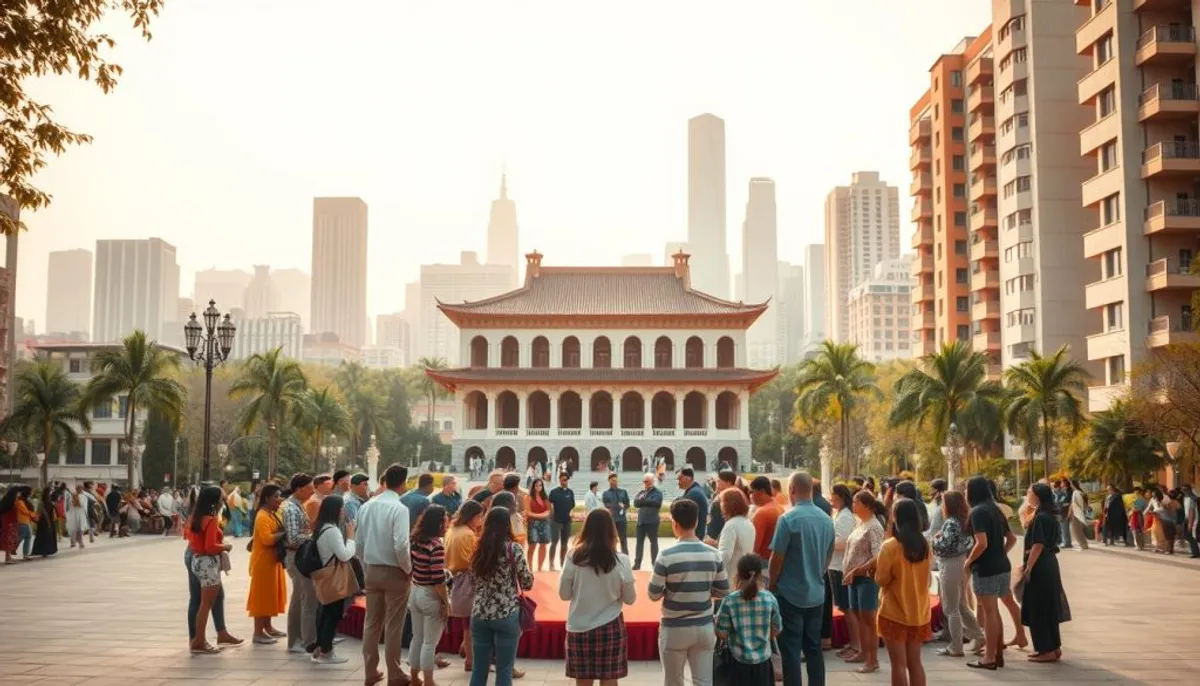Are you wondering what a cultural project is? You are not alone in this inquiry. Such a project aims to enrich the life of a community through art, heritage, or education. It represents an effective means of strengthening the identity and dynamism of a territory.
The definition of a cultural project encompasses a range of initiatives. It can involve the creation of a theater festival or the restoration of a historical monument. The essential aspect is that it reflects the cultural values of a city or a group of citizens.

An eloquent example is the celebration of the 20th anniversary of the archaeological museum of Jublains. This type of event perfectly illustrates the concept of a cultural project. It enhances local heritage while strengthening social ties.
Cultural projects play an essential role in our society. They encourage creativity, strengthen the sense of belonging, and stimulate the local economy. This is why communities are increasingly interested in these initiatives.
Ready to explore the captivating universe of cultural projects? In this guide, we will discover together the various aspects of these initiatives that energize our communities.
What is a cultural project
A cultural project is an initiative aimed at promoting and disseminating culture in various forms, integrating aspects of culture and development. It includes a variety of projects, from artistic exhibitions to music festivals.
The fundamental definition of a cultural project
A cultural project is a structured approach aimed at creating, preserving, or sharing works, traditions, or artistic knowledge. It is part of a territorial cultural policy, essential for sustainable cultural development.
The essential components
The key elements of a cultural project include:
- A clear artistic or heritage objective
- A defined target audience
- A budget and a financing plan
- A team of professionals and volunteers
- A timeline for execution
The main objectives
Cultural projects generally aim to:
- Encourage access to culture for all
- Preserve and enhance heritage
- Stimulate artistic creation
- Strengthen social ties
For example, the “Culture Health” program funds about 600 projects per year, with a budget of 5 million euros. It aims to promote access to culture in hospital settings.
The different types of cultural projects
The management of cultural projects encompasses a variety of initiatives, each with its own challenges and objectives. Enhancing heritage and encouraging artistic creation are at the heart of these projects. They profoundly enrich our society.
Artistic and creative projects
These projects aim to support contemporary creation. They may include exhibitions, live performances, or artist residencies. The management of cultural projects in this field requires a fine understanding of the needs of artists and the audience.
Heritage projects
The enhancement of heritage is crucial for preserving our cultural legacy. These projects may involve the restoration of monuments, digitization of archives, or the creation of historical trails. They require specific expertise and careful attention to conservation standards.
Cultural education projects
Artistic and cultural education aims to raise awareness among all audiences about art and culture. These initiatives can take the form of workshops, guided tours, or school programs. They require close collaboration between cultural institutions and educational establishments.
Cultural mediation projects
Cultural mediation seeks to create connections between works, artists, and the public. These projects may include meetings, debates, or innovative interpretation tools. They play a crucial role in the accessibility and democratization of culture.
| Type of project | Main objective | Example |
|---|---|---|
| Artistic and creative | Support contemporary creation | Contemporary music festival |
| Heritage | Preserve and enhance cultural heritage | Restoration of a medieval castle |
| Cultural education | Raise awareness of art and culture | Painting workshops for children |
| Cultural mediation | Facilitate access to and understanding of works | Interactive guided tours in a museum |

Methodology for building a cultural project
The management of cultural projects requires a methodical approach to ensure its success. The first step, which is essential, can last from 1 to 6 months. It involves conducting a comprehensive inventory of existing cultural resources. This includes facilities and initiatives already in place.
To ensure the success of such a project, creating a framework document is essential. This document details the actions to be taken, the resources allocated, and the deadlines to be met. Projects can extend up to 10 years, requiring meticulous planning.
The facilitation of the approach is crucial in cultural project management. It can manifest in various ways:
- Establishing steering committees
- Communication via the community's newsletter
- Organizing follow-up committees
- Holding regular meetings with local stakeholders
The success of a cultural project relies on continuous evaluation and regular adjustments. It is crucial to maintain constant dialogue with cultural stakeholders, the population, and elected officials. Rigorous monitoring, based on realistic indicators, ensures the relevance and effectiveness of the project in the long term.
The key players in a cultural project
The management of cultural projects requires close collaboration among various stakeholders. Each plays a vital role in ensuring the success and impact of cultural projects in the territory.
Local authorities
Local authorities are at the heart of the local cultural dynamic. For example, the Community of Agglomeration of Saint-Dié-des-Vosges, composed of 77 municipalities and 81,000 inhabitants, initiated a territorial cultural project in 2019. This approach, encouraged by the DRAC, illustrates the commitment of local authorities to cultural development.
Cultural institutions
Museums, libraries, and cultural centers play a major educational role. 80% of modern museums offer educational programs, enhancing the cultural understanding of the public. These institutions are crucial for the preservation and transmission of heritage.
Artists and creators
Artists are the engines of cultural innovation. 75% of contemporary artists mix various cultural influences, thus creating new forms of expression. Their remuneration is an important aspect of cultural project management, with a recommended rate of about 269 euros gross for a half-day intervention.
Audiences and residents
The engagement of the public is crucial for the impact of cultural projects. Live events, such as concerts or exhibitions, can achieve engagement rates exceeding 70%. Cultural festivals, gathering between 5,000 and 200,000 participants, are ideal platforms for promoting cultural diversity.

| Actor | Role | Impact |
|---|---|---|
| Local authorities | Initiation and support of projects | Local cultural development |
| Cultural institutions | Education and preservation | Enhancement of cultural understanding |
| Artists and creators | Innovation and expression | New forms of art |
| Audiences and residents | Participation and engagement | Success of cultural events |
Funding cultural projects
Funding cultural projects and developing an artistic project are essential in cultural project management. In France, several funding sources support these creative initiatives. These funds enable the realization of enriching projects for society.
Public funding sources
The state is a key player in the funding of cultural projects. In 2019, 17 billion euros were allocated to culture. Among them, 3.6 billion were provided by the Ministry of Culture. Local authorities contributed 8.7 billion euros.
Private funding
Corporate sponsorship is an attractive option for funding cultural projects. Companies can benefit from a tax deduction of up to 60% of their investment. This measure encourages partnerships between art and business.
Innovative economic models
New funding models are emerging to support cultural projects. The Territorial Innovation Fund, for example, supported nearly 150 projects in 2022 for an amount of 5 million euros. Initiatives like “En Vies” or “Paye ta frite” showcase the diversity of funded projects. They range from traveling performances to writing workshops for young detainees.
| Type of funding | Amount (in billions of euros) | Example of project |
|---|---|---|
| State | 8.0 | School outings, art schools |
| Local authorities | 8.7 | Local festivals, artist residencies |
| Innovation fund | 0.005 | Project “En Vies”, “Paye ta frite” |
Evaluation and impact of cultural projects
Evaluation is fundamental for the success of cultural projects. It allows measuring their impact and improving their effectiveness. This often neglected step is crucial for ensuring the sustainability and success of cultural initiatives.
It is essential to define clear objectives from the outset. These objectives must be measurable, whether general or specific. For example, aiming for a 20% increase in cultural participation or reaching a new target audience.
Success indicators should be both quantitative and qualitative. They can include the number of participants, but also public satisfaction and changes in perceptions.
- Involve all stakeholders in the evaluation
- Collect data throughout the project
- Use the results to improve future projects
Continuous evaluation allows for adjustments to the project along the way. It optimizes its impact. It also offers the opportunity to strengthen the engagement of volunteers and partners, contributing to the overall success of the cultural project.
Contemporary challenges of cultural projects
Cultural projects are subject to constant transformations, reflecting the evolution of our society. Three major challenges are emerging today: digital transition, sustainable development, and social inclusion. These aspects profoundly shape the impact of cultural projects on our communities.
The digital transition
Digital technology is revolutionizing cultural creation and dissemination. In France, the 16,500 libraries and media libraries are adapting by offering digital resources. In Valognes, a town of 7,000 inhabitants, virtual contemporary art galleries have been created in schools. This illustrates how digital technology can make culture more accessible.
Sustainable development
Cultural projects are increasingly integrating environmental concerns. A striking example is the 5-year residency of a theater company in the Natural Park of the Montagne de Reims. This project involved 150 volunteers, combining culture and environmental awareness.
Social inclusion
Social inclusion is paramount in cultural projects. Since 2015, cultural rights have been recognized by French law, highlighting the importance of access to culture for all. In Romorantin-Lanthenay, after the floods of 2016, cultural initiatives played a crucial role in rebuilding social ties.
| Challenge | Example | Impact |
|---|---|---|
| Digital transition | Virtual galleries in Valognes | Democratization of art |
| Sustainable development | Theatrical residency in a natural park | Environmental awareness |
| Social inclusion | Post-flood projects in Romorantin | Rebuilding social ties |
These challenges redefine the impact of cultural projects, making them more accessible, sustainable, and inclusive. They encourage cultural actors to rethink their approaches to meet the needs of our evolving society.
Conclusion
The success of a cultural project requires meticulous planning and close collaboration. Since the 1980s, cities have played a crucial role in defining cultural policies. The decentralization reform of 1982-1983 is a notable example.
The impact of cultural projects on territorial dynamics and cohesion is undeniable. The mission of cultural planners, conducted from 2021 to 2022, highlighted the importance of citizen participation. This approach allows for addressing local needs and strengthening community ties.
To ensure the success of a cultural project, it is crucial to consider the specificities of the territory. Current issues, such as digital transition and sustainable development, must be integrated. Establishing clear and measurable objectives is also essential. A Scientific, Cultural, Educational, and Social Project (PSCES) over five years, with a thorough analysis of the local context, is a valuable tool for guiding and evaluating the impact of projects.
RelatedRelated articles


